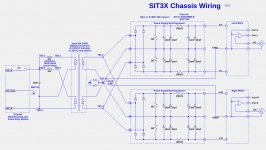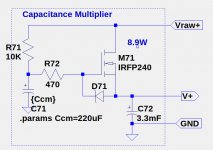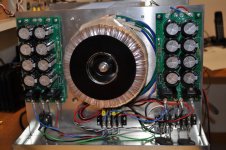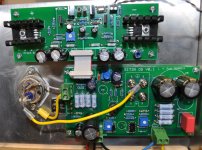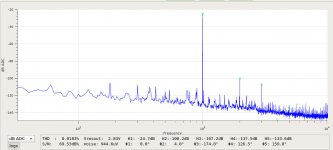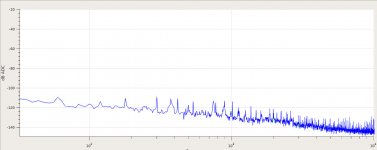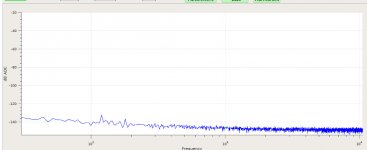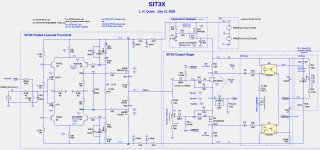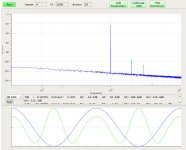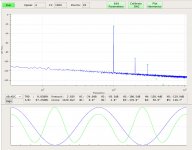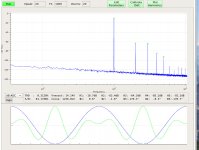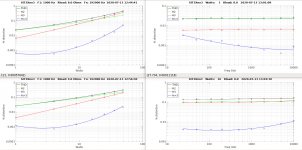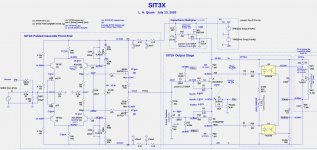The LT4320 based PCBs that I have used so far have places for CX, CS and RS components on the AC side.
There may be space for such components but there is absolutely no reason for using them. Whoever designed your boards added those as a fashion statement 🙂
I did some power supply related measurements today. The basic power supply for the SIT3X is show in the first image below. The V+ and V- rails measure +/-45V DC with 44mV RMS ripple.
The capacitance multiplier on the OS PCB is shown in the second image. The filtered output measures somewhere between 100uV and 300uV RMS noise, basically below the measurement limits of my Fluke multimeter.
The capacitance multiplier on the OS PCB is shown in the second image. The filtered output measures somewhere between 100uV and 300uV RMS noise, basically below the measurement limits of my Fluke multimeter.
Attachments
Here are some spectral measurements of the SIT3X speaker terminals with an 8R load.
- The first image is spectrum of the output with the OS stage only, ie. the FCFE ribbon cable jumper has been removed. I measured 0.1mV RMS noise across the speaker terminals.
- The second image is the spectrum of output with both the FCFE and the OS stages and 0V input. I measured 0.4mV RMS noise across the speaker terminals.
- The third image shows the spectrum for 1kHz, 1Watt into 8R.
Attachments
Finally, after fixing PCB layout errors, circuit modifications, and changes to FETs and resistor valuse, I have good results with the SIT3X build. The circuit measurements agree quite well with my simulations. I find that the "distortion-cancellation" (actually Schade feedback) pot has a significant influence on the distortion spectrum, H2, H3 and higher. Below is a schematic for the current state of the FE and OS circuits.
Is is important to understand that this circuit has no feedback in the FE and no global feedback. The OS contains a adjustable Schade (local) feedback on the PFET connected to the negative rail.
Is is important to understand that this circuit has no feedback in the FE and no global feedback. The OS contains a adjustable Schade (local) feedback on the PFET connected to the negative rail.
Attachments
Last edited:
Here are distortion spectra and residual waveforms:
The power supply noise (harmonics of 60Hz) is below the noise level.
- 1kHz, 1 Watt, 8R load
- 1kHz, 2 Watt, 4R load
- 1kHz, 25 Watt, 8R load
- 1kHz, 50 Watt, 4R load
The power supply noise (harmonics of 60Hz) is below the noise level.
Attachments
Great work Lynn,
How does it sound compared to your previous builds?
The 50 watt output is most interesting with no global feedback. I like it.
Also, where will the fan(s) be mounted? On top of the case?
How tall are your heatsinks? Are they adequate?
I have 4 each 8" tall HeatsinkUSA that look like the same profile.
Rush
How does it sound compared to your previous builds?
The 50 watt output is most interesting with no global feedback. I like it.
Also, where will the fan(s) be mounted? On top of the case?
How tall are your heatsinks? Are they adequate?
I have 4 each 8" tall HeatsinkUSA that look like the same profile.
Rush
No listening yet, but the first channel is working well enough that it is time to build the second channel and begin listening tests.
I completed adjustments of both channels of the SIT3X. Bench measurements show THD<.5% at 50W and THD<.02% at 1W. By adjusting the "magic distortion pot", the spectra are largely insensitive to the load resistance.
I did some A/B listening comparisons of the SIT3X vs. my ZD25 (a variant of the XA25). As currently adjusted, the SIT3X with no global feedback sounds very similar to the ZD25. The main difference might be due to the much lower damping factor, which I measured to be about 30.
I did some A/B listening comparisons of the SIT3X vs. my ZD25 (a variant of the XA25). As currently adjusted, the SIT3X with no global feedback sounds very similar to the ZD25. The main difference might be due to the much lower damping factor, which I measured to be about 30.
As currently adjusted, the SIT3X with no global feedback sounds very similar to the ZD25. The main difference might be due to the much lower damping factor, which I measured to be about 30.
Lynn,
The lower damping presents itself how? Flabbier base?
Are the power supplies equivalent?
Rush
The SIT3X bass behavior seems to be a bit less controlled. The SIT3X power supply uses a 1000VA transformer with 40mF caps per rail. The ZD25 uses a 500VA transformer with 60mF caps per rail. It would be easy to increase the damping factor of the SIT3X by utilizing the feedback input to the folded-cascode front end. It would only require 6dB feedback to obtain a damping factor of around 60.
The ZD25 has a Damping factor of 500, far cry from 30 or 60, but lots of First Watt amps have a low damping factor and sound great.
Some speakers need a lower DF than others.
What speakers are you using and are they hard to drive?
Rush
Some speakers need a lower DF than others.
What speakers are you using and are they hard to drive?
Rush
The difference in the bass control of the SIT3X vs. the ZD25 is subtle and is only detectable when doing frequent A/B switching between the amplifiers. I do not think it indicates any problem or underlying deficiency in the circuit.
Today I intend to explore adding 6dB feedback to see how that changes the sound. The distortion spectrum is already quite good and a bit of feedback will only make it better.
Today I intend to explore adding 6dB feedback to see how that changes the sound. The distortion spectrum is already quite good and a bit of feedback will only make it better.
Waiting with bated breath.
Definitely want in on the group buy for this amp. Actually want an extra pair of the front end boards to try with my Burning amp.
Rush
Definitely want in on the group buy for this amp. Actually want an extra pair of the front end boards to try with my Burning amp.
Rush
Thgat is a good idea, but I am not sure where I can find suitable ears anywhere nearby.Hi Lynn,
invite a neighbor and make the listening test a small party....
:--))
good luck!
I did more listening today (before making any changes), and I am not sure I would be able to hear any difference between the SIT3X and the ZD25 in a blind A/B test. The "bass control" observation in my post #212 might have been due to a preconceived expectation due to the differences in damping factor.
- Home
- Amplifiers
- Pass Labs
- The SIT-3X Amplifier
